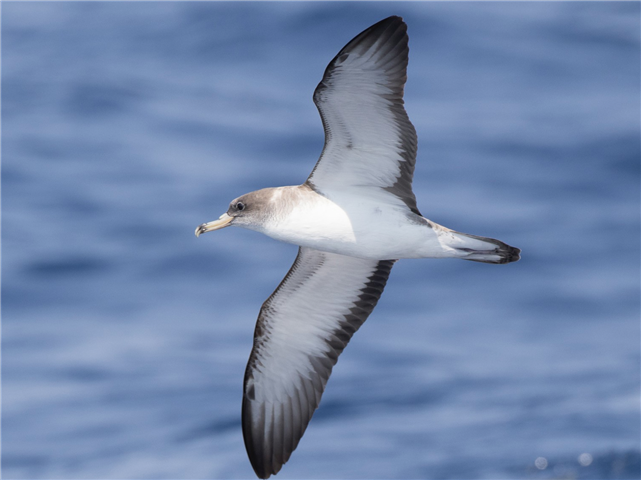Cory's Shearwater
Reports

On Tuesday 27 August 2024 in the early evening, there was a report of Cory’s Shearwater approaching within twenty-five feet of the MV Alfred not long after it left Brodick on its way to Troon. There has never been a confirmed record in Arran waters of Cory’s Shearwater.
Cory’s Shearwater is a rare vagrant in the Firth of Clyde. They breed across the Atlantic archipelagos; the Azores, Canaries, Madeira, Salvagems and Berlengas, all have breeding colonies. Birds start to leave these colonies during August, with many heading for the Bay of Biscay. Some years there are thousands there. Some head further north into UK waters, but numbers can be very variable depending on weather conditions with some years hardly any reports. Cory’s Shearwaters are oceanic birds spending the winter off the coasts of South America and South Africa before returning to their breeding colonies during March.
It is during the late summer months that this large brown and white shearwater, with its languid flight, visits our waters. Cory’s Shearwater is large, (45–56 cm (18–22 in) in length and with a wingspan of 112–126 cm (44–50 in).) It has brownish-grey upperparts, white underparts and a yellowish bill. It lacks the brown belly patch, dark shoulder markings and black cap of the other vagrant large shearwater, the Great Shearwater. The two species also fly differently. Cory’s Shearwater flies with long glides, and always with wings bowed and angled slightly back, unlike the stiff, straight-winged flight of the similarly sized Great Shearwater.
On that late August evening, Nick Giles and his father Mike, both very experienced birdwatchers were on the ferry to the mainland. In Nick’s own words “I was sitting with my parents on the port side of the enclosed main deck of MV Alfred which has large windows and we were sitting at a window seat. I was facing forward, and my father was opposite me facing backwards. I was looking out for Manx Shearwater…….a large heavy looking Shearwater slowly glided past the boat at eye level to me, making just a couple of lumbering wing beats. The very light coloured and long Shearwater’s beak and the Shearwater shaped head were very noticeable to me and it seemed pure white underneath with no dark markings on the belly…..I grabbed my camera and headed up to the upper deck to see if I could see the bird again and photograph it. I didn’t see it again but there were plenty of Manx Shearwater viewed for the next 20 minutes as well as an European Storm Petrel.” You get a sense of the excitement. The image illustrating this article matches the image in Nick’s eye but unfortunately it was not captured in Nick’s camera. There was much discussion with both observers drawing on their previous experience. Nick had seen Cory’s Shearwater with a local guide in Portuguese waters as well as similar shearwaters in pelagic trips in Australia. They were100% certain that they had just seen a Cory’s Shearwater and have submitted the appropriate completed form to the Scottish Birds Rarities Committee (SBRC) for their consideration and hopefully ratification of a first Arran record.
To date there have been no confirmed Arran records. Although reports of Cory’s Shearwater had appeared in previous Arran annual bird reports, namely 1984, 1997 and 2012, these were called "possible" and no forms were submitted to the SBRC for ratification. In addition, there have been no accepted records from Clyde/Clyde Islands but there have been eleven accepted Ayrshire records, all from last century, and nine accepted Argyll records including two this century, one at Machrihanish in 2002.
This August the weather was conducive to driving Cory’s Shearwater north after leaving their breeding grounds with a series of Atlantic fronts, some storm force, moving through. An examination of the national Bird Guides website shows in August for Scotland 39 records (as yet none confirmed), 15 from the Outer Hebrides, 8 from Fife/Lothian, 5 from the Northern Isles with, closer to home, one off Dumfries and Galloway on 23 August and one off Argyll on 30 August.
What about the Arran record on 27 August? We will have to wait for the deliberations of the Scottish Birds Rarities Committee (SBRC). I will keep you posted.
(Photo of Cory's Shearwater by Brian Sullivan)